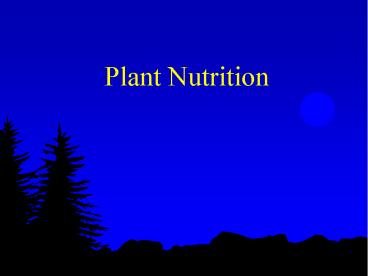Plant Nutrition - PowerPoint PPT Presentation
Title:
Plant Nutrition
Description:
Plant Nutrition Uptake of Nutrients Macro nutrients Carbon - organic compounds Oxygen - organic compounds Hydrogen - organic compounds Nitrogen - nucleic acids ... – PowerPoint PPT presentation
Number of Views:145
Avg rating:3.0/5.0
Title: Plant Nutrition
1
Plant Nutrition
2
Uptake of Nutrients
3
Macronutrients
- Carbon - organic compounds
- Oxygen - organic compounds
- Hydrogen - organic compounds
- Nitrogen - nucleic acids, proteins
- Sulfur - proteins
- Phosphorus- nucleic acids, lipids
- Potassium - Protein Synthesis
- water balance
- Calcium - cell walls, membranes,
- permeability
- Magnesium - chlorophyll, enzymes
4
Micronutrients
- Chlorine - water balance,
- photosynthesis
- Iron - cytochromes
- Boron - chlorophyll synthesis
- Manganese - amino acids
- photosynthesis
- Zinc - Chlorophyll synthesis
- Copper - enzymes for redox rxns
- Molybdenum - nitrogen fixation
- Nickel - Cofactor in nitrogen
- metabolism
5
Soil
- Develops from weathered rocks
- Anchors plants
- Provides water
- Provides dissolved minerals
6
Soil Texture
- Pertains to sizes of soil particles
- includes the following
- sands (0.02 - 2 mm)
- silt (0.002 - 0.02 mm)
- clay (less than 0.002 mm)
7
Soil Composition
- Made up of sand, silt, clay, rocks, humus,
microorganisms (bacteria, fungi, algae, protists,
insects, worms, roots) - Soil contains a mixture of different sized
particles - loam - (40, 40, 20) - fertile
8
The availability of soil water and minerals
9
The availability of soil water and minerals
- Plant takes up water not tied to hydrophilic soil
particles - Positively charged ions attach to soil and
negatively charged ions are lost - Hydrogen ions help displace minerals attached to
soil - Roots add hydrogen ions to the soil through the
release of carbon dioxide (reacts with water to
form carbonic acid)
10
The availability of soil water and minerals
11
Soil Conservation
- Fertilizers
- (Nitrogen, Phosphorus, Potassium)
- Irrigation
- Erosion
12
Nitrogen Fixation
13
Nitrogen Fixation
- Plants absorb nitrogen in the form of nitrate
- Nitrogen-fixing and ammonifying bacteria produce
ammonium - Ammonium is shifted to nitrate by nitrifying
bacteria - Plants shift nitrate back to ammonium for use
14
Nutritional Adaptations
- Root nodules (legumes)
15
Root Nodule
- Roots emit chemical that attract bacteria that
stimulates root hair growth - Bacteria penetrates the root cortex
- Growth continues and includes pericycle which
forms a nodule - Growth continues to include vascular tissue
16
Nutritional Adaptations
- Mycorrhizae (mutulalistic)
- ectomycorrhizae (surface sheath)
- endomycorrhizae (no sheath)
17
Nutritional Adaptations
- Parasitic plants
- haustoria
- mistletoe
- dodder
- Epiphytes
- bromelids / orchids
- Carnivorous plants
- obtain nitrogen minerals from animals































